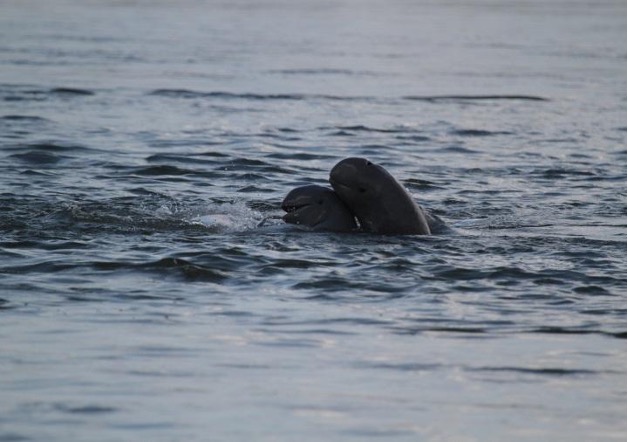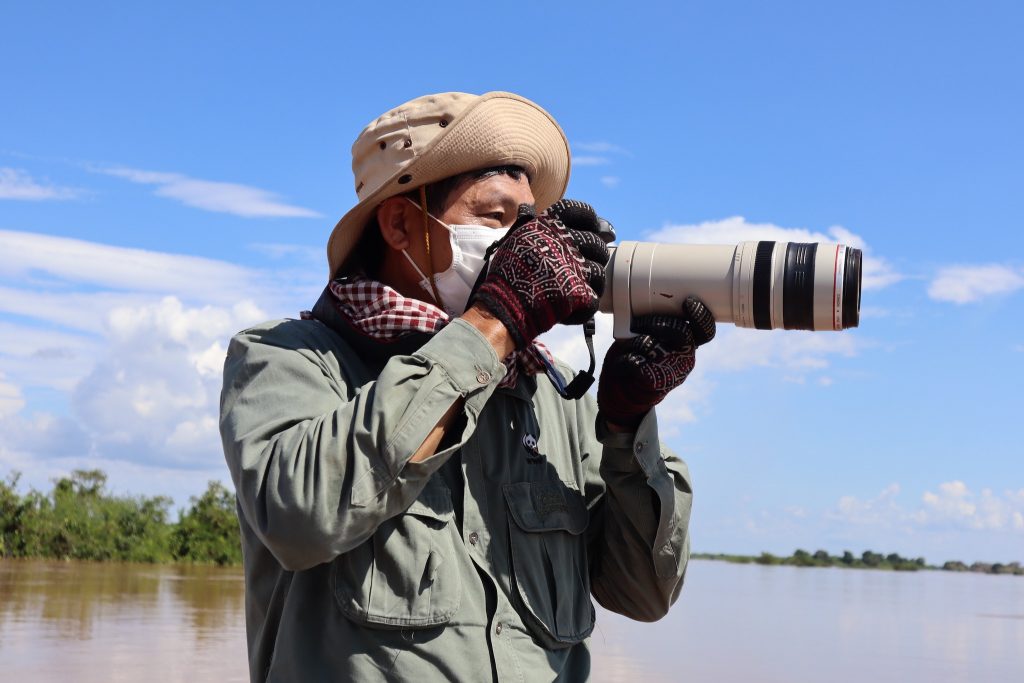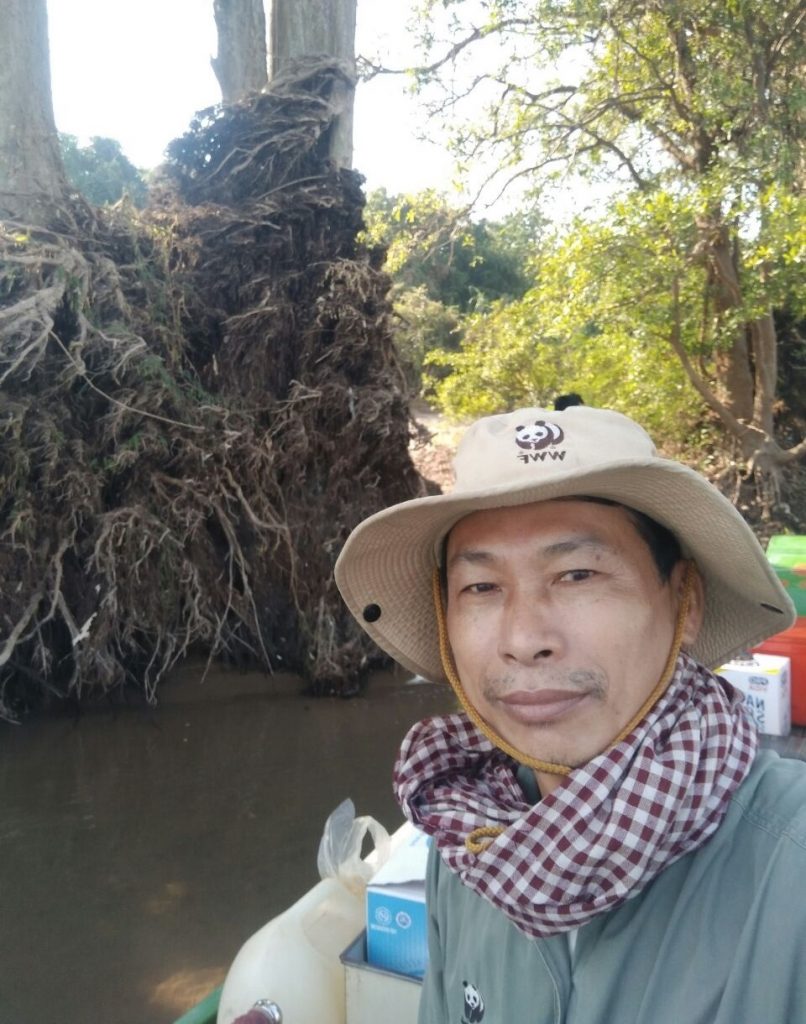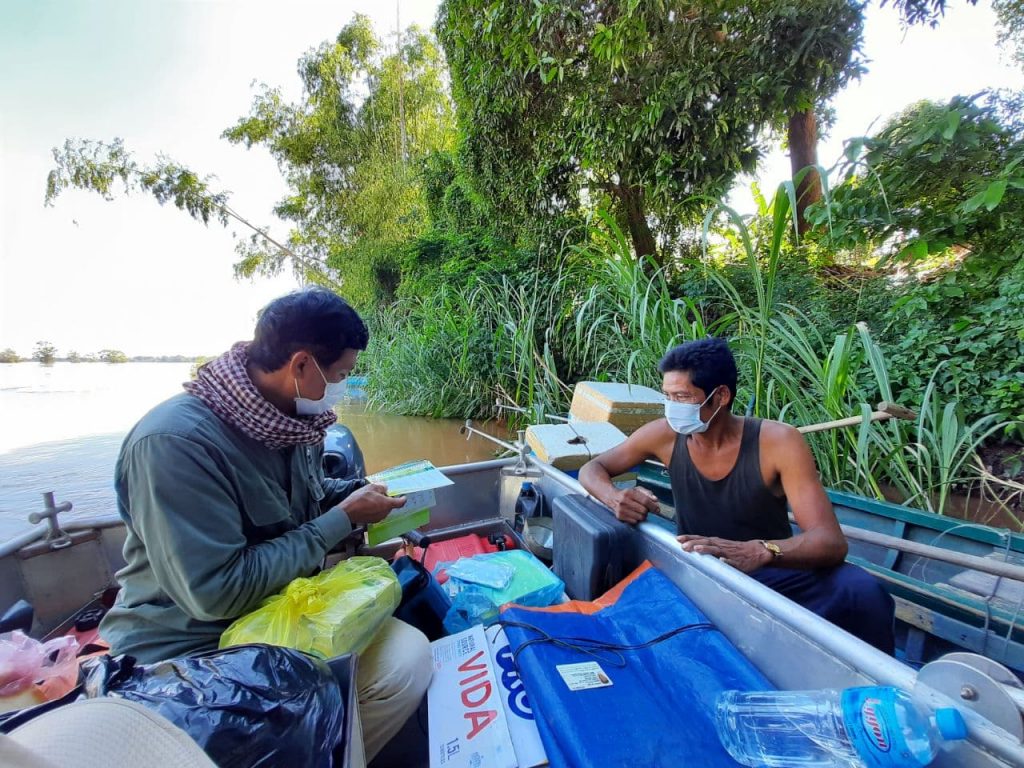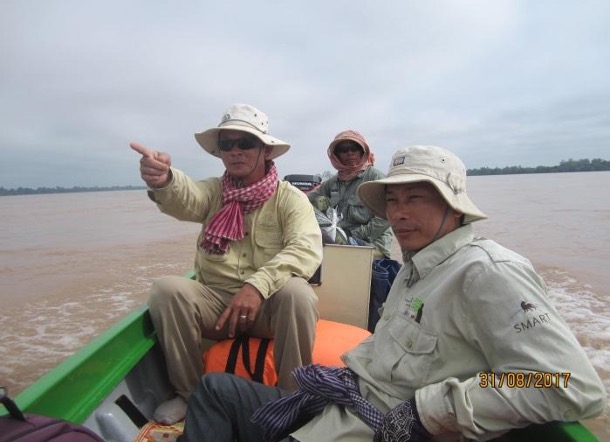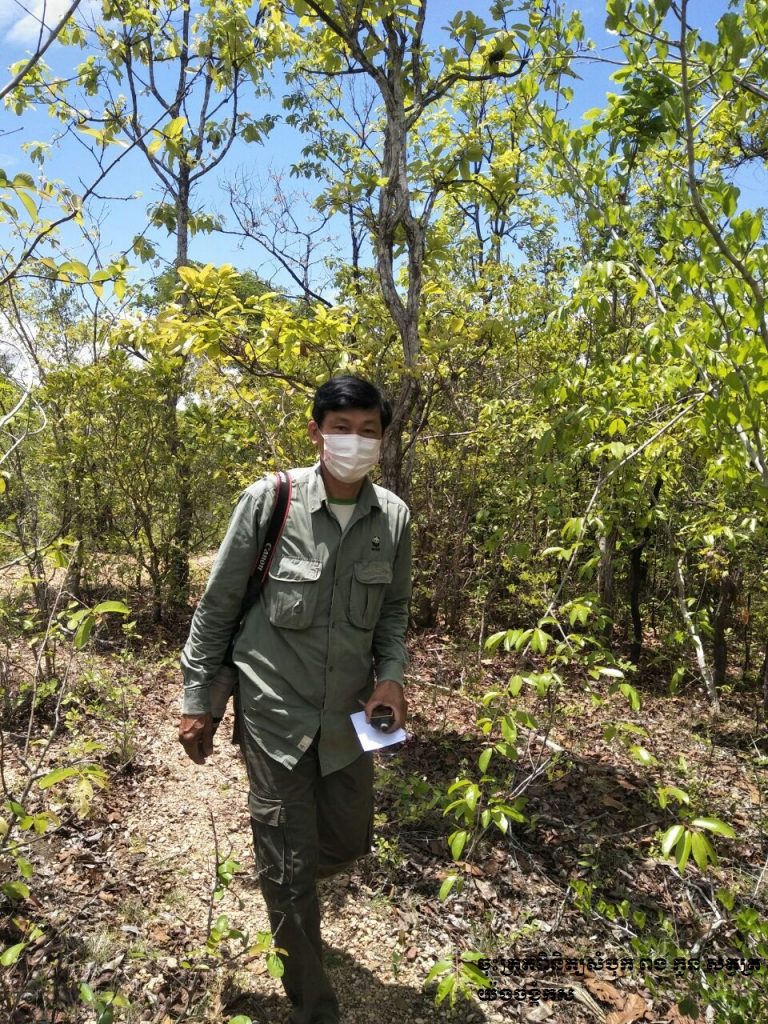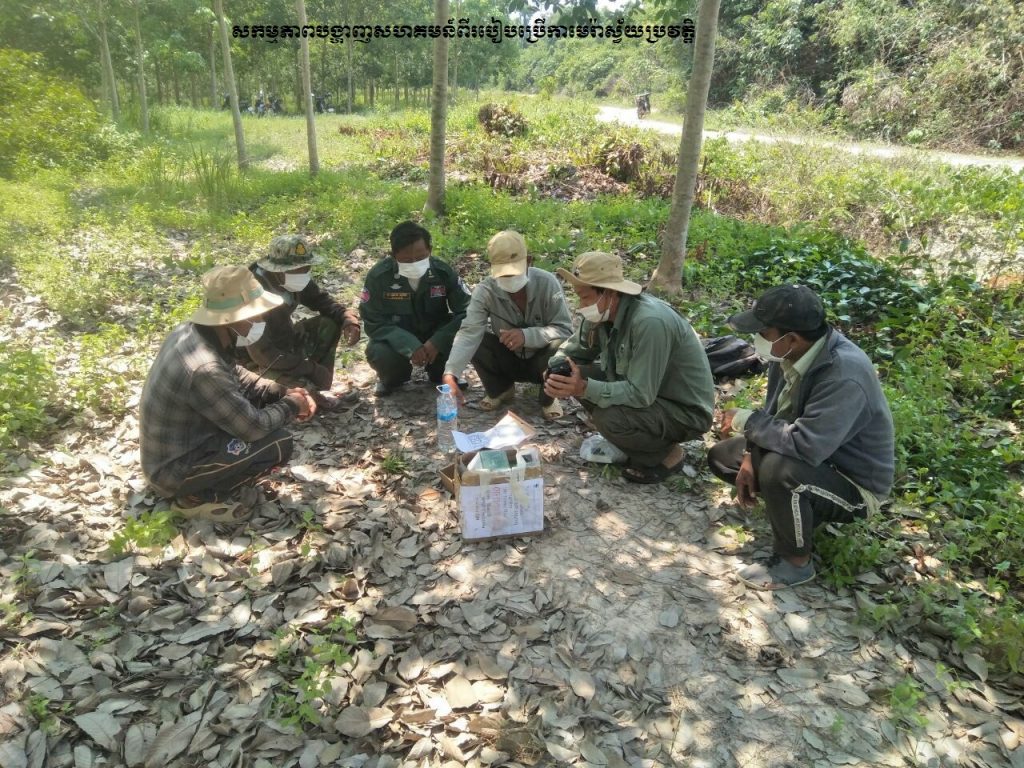បុគ្គលឆ្នើមក្នុងការងារអភិរក្សទន្លេមេគង្គ៖ ឡោ គឹមសាន
ចេញផ្សាយផ្សាយ៖ ០៩ សីហា ២០២២
#មាតិកាប្រព័ន្ធបណ្ដាញសង្គម
We’d like to introduce you to Lor Kimsan, part of our current class of Mekong Conservation Heroes! Lor Kimsan is a Research Project Officer at WWF-Cambodia. (*English below*)
លោក ឡោ គឹមសាន ជាមន្ត្រីស្រាវជ្រាវគម្រោងនៃអង្គការ WWF-កម្ពុជា។
ខ្ញុំបាទឈ្មោះ ឡោ គឹមសាន ភេទ ប្រុស អាយុ ៤៨ឆ្នាំ មានប្រពន្ធ និងកូនស្រីចំនូនពីរនាក់។ ជាអ្នកមានស្រុកកំណើតនៅក្នុងភូមិសំបូរ ឃុំសំបូរ ស្រុកសំបូរ ខេត្តក្រចេះ នៅតាមបណ្តោយដងទន្លេមេគង្គ។ បច្ចុប្បន្នរស់នៅក្នុងក្រុងក្រចេះ ខេត្តក្រចេះ ជាប់នឹងដងទន្លេមេគង្គ ដែលជាទន្លេមួយយ៉ាងធំដែលសម្បូរទៅដោយ ជីវៈចម្រុះគ្រប់ប្រភេទដូចជាព្រៃលិចទឹក ត្រីច្រើនប្រភេទ ជាពិសេសសត្វផ្សោតក្បាលត្រឡោក។ ចាប់តាំងពីតូច រហូតដល់ធំដឹងក្តីគ្រួសាររបស់ខ្ញុំបានពឹងអាស្រ័យយ៉ាងខ្លាំងទៅលើទន្លេមេគង្គនេះ ដូចជាការទាញយកនូវផលត្រី មកចិញ្ចឹមជីវិត ទាញយកទឹកមកប្រើប្រាស់គ្រប់ពេលវេលា។ ហើយប្រជាពលរដ្ឋរាប់លាននាក់ក៏ដូចជា គ្រួសារខ្ញុំដែរ ពួកគាត់ពឹងអាស្រ័យទាំងស្រុងទៅលើទន្លេមេគង្គ ដោយទាញយកនូវផលត្រីសម្រាប់ចិញ្ចឹមជីវិត ដីល្បាប់ ទឹកសម្រាប់ប្រើប្រាស់និងធ្វើកសិកម្មរាប់ទសវត្សមកហើយ ។ ប៉ុន្តែជាអកុសលប្រទេសកម្ពុជាយើងឆ្លងកាត់នូវសង្រ្គាមអូសបន្លាយជាច្រើនទសវត្ស ធ្វើឲ្យធនធានត្រី ព្រៃលិចទឹក និងជីវៈចម្រុះជាច្រើនប្រភេទត្រូវបានបាត់បង់ និងបានថយចុះ ជាពិសេសសត្វផ្សោតក្បាលត្រឡោក (Irrawaddy dolphin) ជាសត្វដ៏កម្រនៅលើពិភពលោក និងប្រភេទត្រីមួយចំនួនផងដែរ។
ចាប់តាំងពីឆ្នាំ២០០១ រហូតដល់បច្ចុប្បន្ននេះ ខ្ញុំមានឳកាសបានចូលរួមជាមួយក្រុមការងារដើម្បីការពារ និងអភិរក្សធនធានជីវៈចម្រុះនៅតាមតំបន់ទេសភាពព្រៃលិចទឹកមេគង្គ។ ទោះបីក្នុងពេលអនុវត្តការងារមានការលំបាកជាច្រើនដែលត្រូវឆ្លងកាត់ដូចជា ខ្យល់ ភ្លៀង កំដៅថ្ងៃក្តៅខ្លាំង ទឹកហូរខ្លាំងនិងឆ្លងកាត់ទឹកជួរជាច្រើន ក៏ក្រុមការងារអាចធ្វើវាបានជោគជ័យដោយសារឆន្ទៈចូលរួមការពារធនធានជីវៈចម្រុះនៅតាមដងទន្លេមេគង្គ ជាពិសេសសត្វផ្សោតក្បាលត្រឡោក។ ព្រោះការបាត់បង់នូវប្រភេទសត្វផ្សោតគឺបង្ហាញពីការខូចគុណភាពទឹក ទន្លេមេគង្គ និងជីវៈចម្រុះដែលបានពឹងអាស្រ័យទៅលើទន្លេនេះ កំពុងរងនូវហានិភ័យពីការប្រែប្រួលអាកាសធាតុ និងហានិភ័យផ្សេងៗពី សកម្មភាពរបស់មនុស្ស។ បច្ជុប្បន្នសត្វផ្សោតទន្លេមេគង្គមានវត្តមាននៅតែក្នុងខេត្ត ក្រចេះ និងខេត្តស្ទឹងត្រែងតែប៉ុណ្ណោះ ដែលពួកវារស់នៅតាមអន្លង់ជ្រៅៗទាំងប្រាំបួននៅក្នុងរដូវប្រាំងរួមមាន ក្នុងខេត្តក្រចេះ អន្លង់កាំពី ជ្រោយបន្ទាយ អន្លង់កន្ទុយកោះរងាវ អន្លង់កោះផ្តៅ អន្លង់សំប៉ានខ្សាច់ម្កាក់ អន្លង់កោះដំបង និងក្នុងខេត្តស្ទឹងត្រែងរួមមាន អន្លង់ត្បូងខ្លា អន្លង់កោះកូនសត្វ អន្លង់កោះសន្ទក់ និងអន្លង់ឈើទាល នៅជាប់ព្រំដែនខ្មែរឡាវ។
ទន្លេមេគង្គកម្ពុជាគឺ ជាទន្លេមួយយ៉ាងសំខាន់ដែលបានផ្តល់នូវផលប្រយោជន៍ និងបម្រើការរស់នៅ យ៉ាងធំសម្បើមដល់មនុស្សរាប់លាននាក់រួមមាន ផ្នែកកសិកម្ម ផ្នែកគមនាគមន៍និងផ្តល់នូវធនធានត្រី ធនធានជីវៈចម្រុះ ផ្សេងៗទៀតជាច្រើន ។ ហើយវាមានសក្តានុពលបំផុតសម្រាប់ការស្តារឡើងវិញនូវប្រភេទជីវៈចម្រុះជាច្រើនប្រភេទដែលកំពុងទទួលរងគ្រោះដោយសារសកម្មភាពរបស់មនុស្ស។ ដោយឃើញនូវស្ថានភាពបែបនេះធ្វើឲ្យរូបខ្ញុំកាន់តែមានទឹកចិត្ត និងឆន្ទៈក្នុងការចូលរួមការពារ និងអភិរក្សនូវប្រភេទសត្វកម្រជាច្រើនដូចជា សត្វផ្សោត សត្វក្តាន់ ប្រភេទសត្វស្លាបកម្រ។ល។ សកម្មភាពទាំងអស់នេះជាការរួមចំណែកយ៉ាងសំខាន់ជាមួយរាជរដ្ឋាភិបាល ស្ថាប័នជំនាញ អង្គការអភិរក្សនានា ជាពិសេសអង្គការ WWF និងអាជ្ញាធរគ្រប់លំដាប់ថ្នាក់ ប្រជាពលរដ្ឋ មូលដ្ឋាន ប្រជាពលរដ្ឋទូទៅនៅក្នុង និងក្រៅប្រទេស ដើម្បីការពារ អភិរក្សនូវជីវៈចម្រុះគ្រប់ប្រភេទ និងការពារបរិស្ថានទឹកទន្លេមេគង្គឲ្យមានគុណភាពល្អ។ ជាពិសេសការពារផ្សោតទន្លេមេគង្គដែលមានចំនួនប្រមាណតែ ៨៩ក្បាលប៉ុណ្ណោះនាពេលបច្ចុប្បន្ន ឲ្យមានវត្តមាន និងមានចំនួនកើនឡើង។ វាមានសារៈប្រយោជន៍យ៉ាងខ្លាំងសម្រាប់វិស័យទេសចរណ៍ ដែលជួយការលើកកំពស់ ជីវភាពសហគមន៍ និងកំណើនសេដ្ឋកិច្ចជាតិ និងការពារបរិស្ថានទឺកទន្លេមេគង្គ ឲ្យបានគង់វង្សសម្រាប់បម្រើមនុស្សជាតិគ្រប់ជំនាន់។
ខ្ញុំបានចូលរួមក្នុងការសិក្សាស្រាវជ្រាវអំពីសត្វផ្សោតទន្លេមេគង្គ នៅក្នុងខេត្តក្រចេះ និងខេត្តស្ទឹងត្រែង អស់រយៈពេលជាង ២០ឆ្នាំ។ ការងាររបស់ខ្ញុំក៏រួមបញ្ចូលការសិក្សាអំពី សត្វក្តាន់ និងប្រភេទសត្វស្លាបកម្រ និងជិតផុតពូជ ដោយសហការជាមួយ ស្ថាប័នជំនាញគម្រោងទេសភាពព្រៃលិចទឹកទន្លេមេគង្គនៃអង្គការ WWF -កម្ពុជា។ សកម្មភាពការងារបច្ចុប្បន្នរបស់ខ្ញុំរួមមានការថតរូបសត្វផ្សោតដើម្បីកំណត់អត្តសញ្ញាណរបស់ពួកវា ការតាមដានសកម្មភាពនេសាទនៅក្នុងតំបន់ការពារសត្វផ្សោត ក៏ដូចជាតាមដានអត្រាកំណើតនៃ កូនសត្វផ្សោតថ្មី និងប្រមូលសំណាកគំរូវិភាគនៃសាកសពសត្វផ្សោត ធ្វើកោសល្យវិច័យលើសាកសពសត្វផ្សោត។ ខ្ញុំក៏បានដាក់កាមេរ៉ាចាប់រូបភាព នៅក្នុងដែនជម្រកសត្វព្រៃសំបូរ និងព្រែកប្រសព្វ ធ្វើការអង្កេត និងកត់ត្រាចំនួនលើសត្វត្រយ៉ងចង្កំកស និងរំពេរទន្លេ ការពារសំបុកសត្វស្លាបកម្រ និងធ្វើការអប់រំ និងសកម្មភាពផ្សព្វផ្សាយជាមួយសហគមន៍។
ការស្រាវជ្រាវជាប់ជាប្រចាំនេះគឺមានសារៈសំខាន់ខ្លាំងណាស់សម្រាប់ការការពារ និងអភិរក្ស ប្រភេទសត្វកម្រ និងជិតផុតពូជ ដូច្នេះយើងអាចស្តារចំនួនប្រភេទសត្វទាំងនេះដែលខិតទៅរកការជិតផុតពូជដូចជា សត្វផ្សោតទន្លេមេគង្គ សត្វក្តាន់ សត្វត្រយ៉ងចង្កំកស សត្វត្រយ៉ងយក្ស សត្វរំពេរទន្លេ និងសត្វត្មាត ឲ្យមានចំនួនកើនឡើងវីញក្នុងធម្មជាតិ។ វត្តមានរបស់ប្រភេទសត្វទាំងនេះបង្ហាញពីសុខមាលភាពបរិស្ថានក្នុងតំបន់ ជាពិសេសសុខមាលភាពទន្លេមេគង្គ និងបរិស្ថានជុំវិញរបស់វា ដែលផ្តល់អត្ថប្រយោជន៍ដល់មនុស្សជាតិ គ្រប់ពេលវេលា។ ខ្ញុំចង់ឲ្យប្រជាជនកម្ពុជាទាំងអស់យល់ដឹងថា គោលបំណងនៃការស្រាវជ្រាវរបស់យើង គឺដើម្បីទទួលបានព័ត៌មានលម្អិតអំពីប្រភេទសត្វដែលកំពុងប្រឈមនឹងការផុតពូជ។ ការថយចុះនៃ ប្រភេទសត្វទាំងនេះនឹងផ្លាស់ប្តូរបរិយាកាសនៃភពផែនដី និងប៉ះពាល់យ៉ាងធ្ងន់ធ្ងរដល់ជីវិតប្រចាំថ្ងៃ របស់មនុស្ស ជាតិ។ ព័ត៌មាននេះអាចលើកទឹកចិត្តប្រជាជនទូទៅឲ្យចូលរួមក្នុងការងារការពារ និងអភិរក្ស ធនធានធម្មជាតិ នៅក្នុងតំបន់របស់ពួកគាត់។
My name is Lor Kimsan. I was born in Sambo Village in Sambo District of Kratie Province, which is located along the Mekong River. Now I live with my wife and two daughters in Kratie Town, Kratie Province, next to the large Mekong River which has abundant biodiversity, such as flooded forests, numerous species of fish, and the very special Irrawaddy dolphins. From when I was a young boy to my adulthood, my family relied heavily on the Mekong River for fishing as part of our livelihood activities, and used its water for all purposes. Like my family, millions of people rely entirely on the Mekong River by extracting fish for food, and have taken benefits from rich river sediment and water for agricultural purposes for decades. Unfortunately, Cambodia went through decades of protracted war which depleted and decreased fisheries resources, flooded forests, and biodiversity resources. This especially impacted the Irrawaddy dolphin, which is a rare species in the world, as well as some fish species.
From 2001 until now, I have had the opportunity to join my team at WWF Cambodia to protect and conserve biodiversity in the Mekong Flooded Forest Landscape area. Although there are a number of hindrances to overcome, such as field trips during strong wind, rain, heat or boiling sun, and needing to navigate rocky, fast-flowing water while implementing our activities, my team still manages to get our job done successfully because we have a strong will to contribute to the protection of biodiversity along the Mekong River, especially the Irrawaddy dolphins. The decline of dolphins indicates a deterioration in the quality of the Mekong River and the other species that depend on the river, resulting from climate change and other threats from human activities. Currently, Irrawaddy dolphins are found only in Kratie and Stung Treng provinces, where they inhabit nine deep pools in the dry season. These include Anlong Kampi, Chroy Banteay, Anlong Kan tuy koh ngeav, Anlong koh pdao, Anlong koh sam pan ksach makak, Anlong koh dam bang in Kratie Province, and Anlong Tbong Khla, Anlong Koh Kon Sat, Anlong Koh Santuk and Anlong Chheuteal in Stung Treng Province on the Cambodia-Lao border.
Cambodia’s Mekong River is a significant river that has provided enormous benefits and livelihoods to millions of people, including supporting the agriculture sector, transportation, fisheries resources and many other biodiversity resources. There is great potential to restore many species that are suffering from human activities. Seeing this situation makes me even more motivated and willing to participate in protecting and conserving rare species such as dolphins, deer, and rare birds. All of these activities are important contributions to the Royal Government, technical institutions, conservation organizations, especially WWF, and authorities at all levels, local people, and the general public living in Cambodia or abroad. We are working to protect and conserve all kinds of biodiversity and protect the Mekong River environment so that it has good water quality. In particular, it is essential to protect Irrawaddy dolphins, whose current population is only around 89 individuals, so that this species can continue to exist and increase its population. Dolphins are very important for tourism and help to improve community livelihoods and national economic growth while also protecting the Mekong River environment for humans in all generations.
I have been participating in research studies on the Mekong River dolphin in Kratie and Stung Treng Province for more than 20 years. My work also includes the study of deer and rare and endangered bird species in collaboration with technical departments and the Mekong Flooded Forest Landscape of WWF-Cambodia. My current work activities include photographing dolphins in order to identify them, monitoring fishing activities within dolphin protected areas as well as the birth rate of new dolphin calves, and performing autopsies on bodies of dead dolphins. I also set up camera traps in Sambo and Prek Prasob Wildlife Sanctuary, survey populations of White-shouldered Ibis and River Terns, protect the nests of rare bird species, and conduct education and outreach activities with communities.
This ongoing research is very important for rare and endangered species protection and conservation so that we can restore the populations of species on the brink of extinction, such as the Mekong dolphin, deer, White-shouldered Ibis, Giant Ibis, River tern, and vultures. The presence of these species indicates the health of the environment in the region, particularly the health of the Mekong River and its surrounding environment, which provide benefits to humans at all times. I want Cambodian people to understand that the purpose of our research is to obtain detailed information on species that are facing extinction. The decline of these species is changing the environment of the planet and severely impacting the daily lives of people. This information can encourage the public to take part in natural resources protection and conservation work in their local areas.
Please share this post to help others learn about Kimsan’s important work to study and conserve Cambodia’s wildlife! Follow Wonders of the Mekong to learn more about Cambodia’s Mekong Conservation Heroes. Read more about Lor Kimsan at his full profile here: https://www.mekongfishnetwork.org/mekong…/lor-kimsan/
